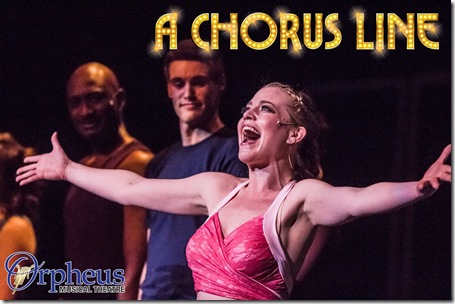Orpheus Shines With A Chorus Line
Photo. Alexander Vlad for Alan Dean
In a theatre community where claims to professionalism are sometimes suspect, Orpheus stands out like shining beacon. It wears its community-theatre label proudly and without pretension. And it often puts to shame some of the tacky touring productions that have lumbered across Canada (and into the NAC) in recent years.
All of which is a preamble to declaring that this organization’s new production of A Chorus Line is another worthy achievement. It remains true to the sensibility of the legendary Broadway original, which was conceived by its first director, the late Michael Bennett, as a bittersweet valentine to the kids in the chorus line, the ones we tend
to take for granted when we watch a stage musical, but who supply the essential support system for any successful show.
Debbie Guilbeault’s production for Orpheus brings out the humour, humanity and heartbreak inherent in material that gives us a collection of young aspirants striving to be among the eight dancers who finally will win a coveted place in an upcoming Broadway show. And as their audition process unfolds before the audience’s eyes, Guilbeault is ensuring that virtually every person involved emerges with a defined personality. Whether it’s Jasmine Lee’s sweetly vulnerable Connie worrying about her height, Morgan Coughtian’s young and naive Mike taking nimble-footed possession of the stage in I Can Do That, or the Diana of Rebeka Tekle taking enjoyable aim at artistic pretension in Nothing, this is a production that celebrates community in all its disparity.
> It also brings off the material’s necessary fusion of Marvin Hamlisch’s music with Edward Kleban’s lyrics and a socially conscious book by James Kirkwood and Nicholas Dante. The songs are well served by the musical direction of Wendy Berkelaar — and in this production they repeatedly remind us of the particular social forces fuelling A Chorus Line 40 years ago when it first exploded on Broadway. There has been some debate over the years about how well the characters in this musical should be able to sing. Should they show the pristine quality of a top-billed star? Or, given the fact that they are being auditioned primarily for their dancing ability, should we cut them some slack? The debate goes on, and from this corner, the singing never seems less than serviceable in this production, emerging in the solos as an extension of personality, and at times — as with Andréa Black’s hilarious hymn to the wonders of plastic surgery in the famous “tits and ass” song — as absolute dynamite. In a show notable for its solid ensemble quality, Black is a stand-out
as the brassily pragmatic Val.
Also exemplary is an enormously affecting Jack MacDougall as Paul, who emotionally relives his
> troubled childhood in that extraordinary monologue that today is a staple in acting classes.
> However, it could be argued that a couple of key characters are a bit off when it comes to interpretation. Rob Henderson seems too much the softy in his portrayal of Zach, the show’s director. Although he has one moment of genuine emotion in the show, we also need to glimpse a character who knows the necessity of making tough and sometimes ruthless decisions.
There’s also a problem with Christa Cullain’s portrayal of Cassie, the showgirl who once seemed headed for stardom
> but now simply wants to make it into the chorus. Cullain can move beautifully in stage, but her characterization seems indistinct — where is the desperation that has brought Cassie to this situation? As for the relationship with Zach that is part of Cassie’s troubled history — well, let’s just say that their emotional connection seems tenuous here.
> A Chorus Line can impose daunting dancing demands on a cast of non-professionals The value of choreographer Derek Eyamie’s contribution to the evening is evident, not just in a lively and creative imagination, but in his skill in determining where the cast’s real dance strengths lie, both individually and collectively, and in harnessing them to the production’s advantage.
Other contributors to the show’s success are set designer Jenn Donnelly, reminding us of the importance of mirror imagery in this musical; costume designer Jay Lackey, whose creations are thoughtful and related to character; and
> Chris Arnott who contributes an effective but quietly unobtrusive lighting design.
>
> A Chorus Line.
>
> Conceived and originally choreographed and directed by Michael Bennett
> Book by James Kirkwood and Nicholas Dante
> Music by Marvin Hamlisch
> Lyrics by Edward Kleban
> Co-choreographed by Bob Avian
> Orpheus Musical Theatre Society
>
>
> Director
> Debbie Guilbeault
> Musical Director
> Wendy Berkelaar
> Choreographer
> Derek Eyamie*
> Technical Director
> Steve Jones
> Set
> Jenn Donnelly
> Costumes
> Joy Lackey
> Lighting
> Chris Amott
> Sound
> John Cybanski
>
> Zach
> Rob Henderson
> Larry
> Drake Evans
> Al
> Thomas Shapiro
> Bebe
> Erynn Paton
> Bobby
> Jeremy Sanders
> Cassie
> Christa Cullain
> Connie
> Jasmine Lee
> Diana
> Rebeka Tekle
> Don
> Blair Laugher
> Greg
> Paddy McCarthy
> Judy
> Nolla Timmins
> Kristine
> Julia Redfern
> Maggie
> Katie Shapiro
> Mark
> Matthew Chin
> Mike
> Morgan Coughlan
> Paul
> Jack MacDougall
> Richie
> Antoine L. Collins
> Sheila
> Cynthia Wood
> Val
> Andréa Black
> Ensemble
> Sierra Brennan, Spencer Cripps, DeNeige Dojack, Mélanie Evans, Rhyanna Melanson,
>
> Joyanne Rudiak, Rob Singlehurst, Sarah Smythe, Marco Walker-Ng
> Pit singers
> Sharon Dickson Jamie Rice
> Orchestra
